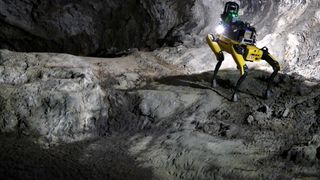Meet Au-Spot, the AI robot dog that's training to explore caves on Mars
Sit! Stay! Fetch! Map a Martian cave!

Mars exploration is going to the dogs. The robot dogs, that is.
Scientists are equipping four-legged, animal-mimicking robots with artificial intelligence (AI) and an array of sensing equipment to help the bots autonomously navigate treacherous terrain and subsurface caves on the Red Planet.
In a presentation on Dec. 14 at the annual meeting of the American Geophysical Union (AGU), held online this year, researchers with NASA/JPL-Caltech introduced their "Mars Dogs," which can maneuver in ways the iconic wheeled rovers such as Spirit, Opportunity, Curiosity and the recently launched Perseverance never could. The new robots' agility and resilience are coupled with sensors that allow them to avoid obstacles, choose between multiple paths and build virtual maps of buried tunnels and caverns for operators at home base, scientists said at AGU.
Related: Super-Intelligent Machines: 7 Robotic Futures
Traditional Mars rovers are limited mostly to flat surfaces, but many scientifically interesting Martian regions are only reachable by crossing very rough terrain or descending below ground. Walking robot "dogs" are well-suited for such challenges — even if they fall down, they can get back up again.
"Toppling does not mean mission failure," the scientists said during the presentation. "Using recovery algorithms, the robot can self-right from a multitude of falls."
A Mars Dog would also be roughly 12 times lighter than current rovers and would be capable of traveling much faster, reaching normal walking speeds of 3 mph (5 km/h) during terrestrial tests. To put that into perspective, the Curiosity rover rolls along the Martian surface at about 0.09 mph (0.14 km/h), the researchers reported.
Get the Space.com Newsletter
Breaking space news, the latest updates on rocket launches, skywatching events and more!
On Mars, caves may offer shelter for future human colonies, providing natural protection against deadly UV radiation, extreme cold and intense dust storms that can last for weeks and are sometimes big enough to be spotted by telescopes on Earth, according to NASA. Caves may also harbor evidence of life from Mars' distant past, or even provide a current home for organisms living deep underground, the researchers said at AGU. Legged robots that can walk around rocks, lower themselves into caves and select a path — while also gathering measurements and building a map of what they "see" — could offer scientists new opportunities to detect signs of life beyond Earth.
The autonomous Mars canine, dubbed "Au-Spot," is a modified version of "Spot," a four-legged mechanical explorer created by the robotics company Boston Dynamics. More than 60 scientists and engineers on the team of Collaborative SubTerranean Autonomous Resilient Robots, or CoSTAR, equipped Au-Spot with networked sensors and software to help it safely and autonomously scan, navigate and map its environment.
Au-Spot processes input from Lidar (remote sensing using laser pulses), visual, thermal and motion sensors to create 3D maps. The Mars Dog also uses AI to learn which structures to avoid, and to identify objects that may be of scientific interest, while a communications module allows the robot to transfer data to the surface while it's exploring underground.
CoSTAR team members are testing Au-Spot in a range of obstacle courses, putting it through its paces in tunnels and hallways; up stairs and ramps; and in outdoor locations that mimic Martian landscapes, such as lava tubes in Northern California. Those demonstrations show that untethered robots can navigate around boulders and map deep caves.
"These behaviors could one day enable revolutionary scientific missions to take place on the Martian surface and subsurface, thereby pushing the boundaries of NASA's capability in exploring traditionally inaccessible sites," the scientists said at AGU.
Originally published on Live Science.
Join our Space Forums to keep talking space on the latest missions, night sky and more! And if you have a news tip, correction or comment, let us know at: community@space.com.

